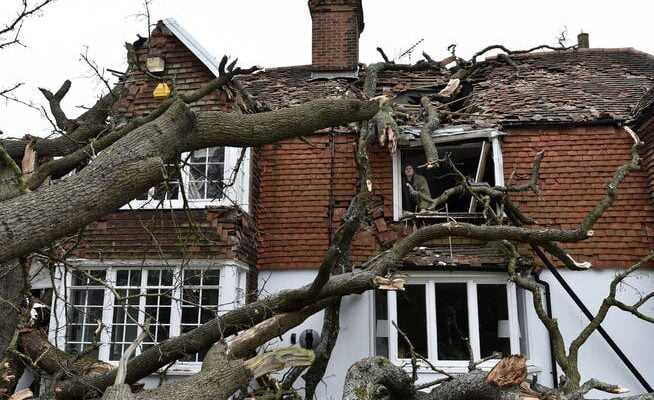“Ylenia” already had bad consequences, then hurricane “Zeynep” brought further destruction. And the start of the week was also unpleasant because of “Antonia”. Towards the evening, the situation should calm down for the time being.
Throughout Europe, three storms have caused severe property damage in the past few days.
kca./(dpa)
Storm and no end: After “Ylenia”, the hurricane “Zeynep” in northern Europe caused fatal accidents and millions in damage at the weekend. And with “Antonia” another storm hit Europe on Monday night, which caused an uncomfortable start to the week in many places.
In view of the considerable damage, international rail travelers with connections to Germany, France and the Netherlands must be prepared for considerable impairments at the start of the week. In particular, with a view to the storm “Antonia” predicted until Monday morning, Deutsche Bahn (DB) asked its passengers to find out whether the planned trip was even possible. SBB also has isolated train cancellations and delays due to strong winds.
Significant avalanche danger
These gusts are likely to become even stronger in large parts of Switzerland in the course of the morning and reach wind speeds of over 100 kilometers per hour in some cases and also lead to heavy showers and thunderstorms. The storm is expected to gradually ease over the course of the afternoon to evening.
The cold front from the storm depression #Franklin sets course for Switzerland and will reach us in the morning hours. In addition to peak gusts of 80 to 110 km/h locally, there are also isolated cases #Thunderstorm possible. https://t.co/JSf1As8e0y
— MeteoSwiss (@meteoSwiss) February 21, 2022
In view of the strong winds, the federal government warns of significant dangers for the coming hours due to gusts of wind in large parts of Switzerland in the coming hours. According to the natural hazard map, danger level 3 means “considerable danger”, since the storms could carry objects, loosen roof tiles, cause trees to fall and cause high waves on the lakes. “In stormy winds, you should therefore avoid spending time outdoors if possible,” advises the federal government.
Extremely strong gusts were measured as early as Monday night, reports SRF Meteo. Around 4:50 a.m., the gusts in eastern Switzerland reached a peak of 147 km/h on the Säntis. It was 134 km/h on the Pilatus, followed by the Napf at 117 km/h. In Zurich the wind blew at 98 km/h and in Plaffeien at 97 km/h.
Had a restless night?? No wonder with such a stormy one #Wind! Stronger ones follow #gusts of wind at times over 100 km/h, #care! #StormAntonia #StormFranklin ^sba pic.twitter.com/95goDGG8T5
— SRF Meteo (@srfmeteo) February 21, 2022
The storm low also brought significantly colder temperatures compared to the previous week. Accordingly, 20 to 60 centimeters of fresh snow can be expected in the mountains. The Institute for Snow and Avalanche Research (SLF) warns that the strong winds can cause strong drifts, which lead to an increased risk of avalanches. Especially on Monday morning there is a considerable risk of avalanches.
At least nine dead so far
The weather situation was already tense throughout Europe before “Antonia”. When the two storms “Zeynep” and “Ylenia” passed, at least nine people died in accidents in Germany, Great Britain and the Netherlands over the weekend. In Germany alone, the two hurricane lows are likely to cost insurers more than 1.4 billion euros, according to initial estimates. It was the most intense storm since “Kyrill” in 2007.
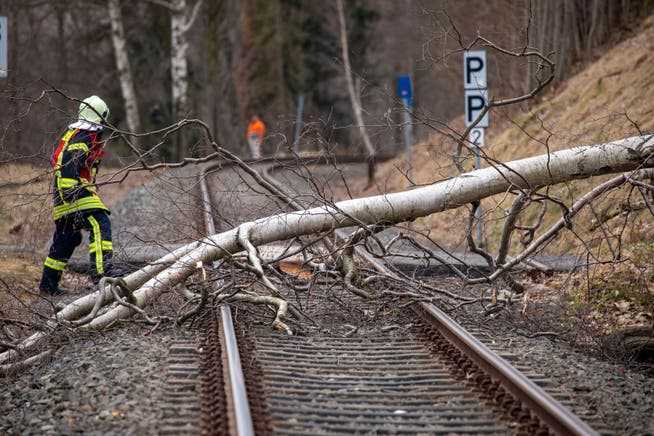
There were disruptions to rail traffic in many places over the weekend.
According to Deutsche Bahn, more than 6,000 kilometers of the route network in Germany were temporarily unusable. Around 2,000 emergency services were on duty around the clock to remove fallen trees and repair overhead lines. “Zeynep” had crossed northern Europe from Friday afternoon with wind speeds of locally more than 160 kilometers per hour.
The fire brigades counted thousands of operations, mostly because of fallen trees, objects flying around or damaged buildings – in the German state of North Rhine-Westphalia alone, they deployed more than 12,000 operations by Saturday noon.
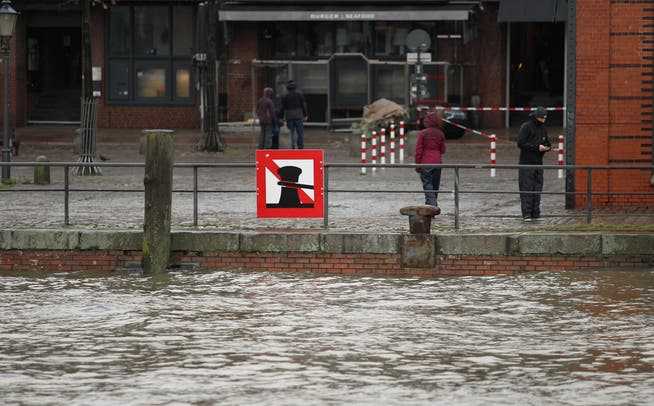
In Hamburg, the water level at the St. Pauli gauge on Saturday morning was 3.75 meters above the mean high water level.
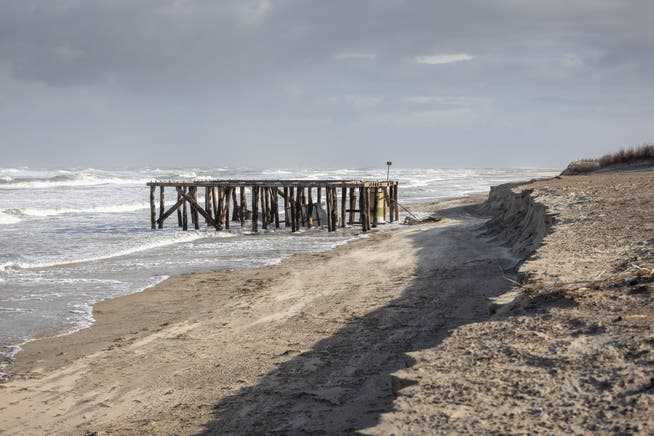
There used to be a beach here: East Frisian islands lost almost their entire beach due to the strong winds.
In Hamburg, for the first time since 2013, there was a very severe storm surge with more than 3.5 meters above the mean high water on Saturday morning. In Bremen, a 55-meter-high construction crane fell into an office building that was still under construction. “It looks devastating,” said a fire department spokesman.
The North Sea island of Wangerooge lost about 90 percent of its beach in the storm. “There is hardly any sand over a distance of one kilometer,” said Wangerooges island mayor Marcel Fangohr. The beach was also damaged on the East Frisian island of Langeoog. “In parts, there is no longer a beach, the edge goes up to the dunes,” said the island’s mayor, Heike Horn.
Hundreds of thousands without power
Three people were killed by falling trees in Amsterdam, including a cyclist. The storm with hurricane-force gusts paralyzed public life in large parts of the country. Train and local public transport were suspended, air traffic was affected. Ireland also reported one fatality. Three people died in the UK when a tree or debris fell on their cars. Hundreds of thousands of people were without power as of Saturday.
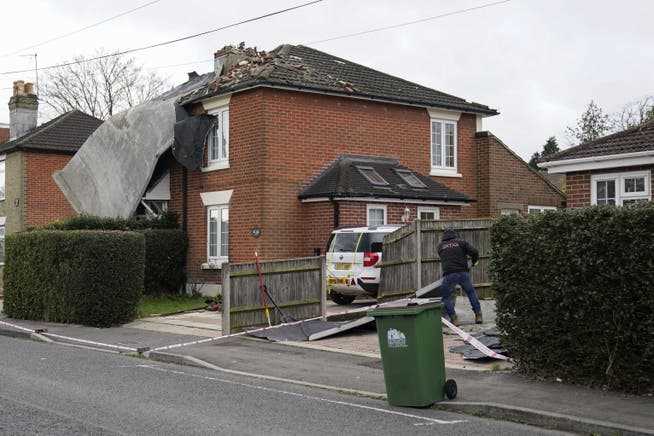
More than 400,000 people in the UK were without power on Saturday.
In London, the highest red warning level was declared for the first time. Videos circulating on the internet showed how the covering of the Millennium Dome in the London Borough of Greenwich was partially torn away. Under the tent-like construction erected at the turn of the millennium is the O2 Arena, where music and sporting events take place.
In the north of France, the storm has meanwhile caused parts of the power grid to collapse. Around 130,000 households were without electricity on Friday evening. For areas affected by the storm, France’s Interior Minister Gérald Darmanin announced that he would declare a disaster in order to facilitate compensation. As the newspaper “Le Parisien” reported, there was considerable damage. Three people were seriously injured and eight others were slightly injured, the prefecture said.
